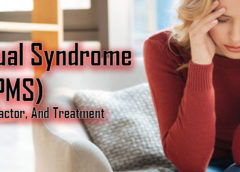What is Premenstrual Syndrome?
Premenstrual syndrome is also knows as PMS. Premenstrual syndrome is a condition that effects on women such as emotions, physical health, and their behavior during the days of the menstrual cycle, generally just before her menses.
Premenstrual syndrome is a very common condition. Its symptoms affect more than 85% of menstruating women. It must impair some aspect of your life for your doctor to diagnose you.
Premenstrual syndrome symptoms start four to ten days before menstruation and go away once menstruation begins. The cause of Premenstrual syndrome is unknown.
However researchers believe that it is related to a change in sex hormone and serotonin levels both at the beginning of the menstrual cycle.
Risk factors for Premenstrual syndrome include:
- Depression or mood swings, such as postpartum depression or bipolar disorder
- Domestic violence
- Substance abuse
- Physical trauma
- Emotional trauma
Associated conditions include:
- Dysmenorrhea
- Major Depressive Disorder
- Seasonal Affective Disorder
Symptoms of Premenstrual syndrome
The symptoms of are usually mild or moderate. About 75% of women report one or more than one symptom that does not substantially affect daily functioning.
Twenty to thirty two percent of women report moderate to severe symptoms that affect some aspect of life. Three to 8% report premenstrual dysphonic disorder (PMDD). The severity of symptoms can vary by individual and by month.
The symptoms of premenstrual syndrome include:
- Abdominal(Intestinal) Swelling
- Abdominal(Intestinal) Pain
- Sore Breasts (Garget)
- Acne
- Cravings for Food Mainly For Sweets
- Constipation
- Sleeping Problems
- Anxiety
- Depression
- Sadness
- Emotional Outbursts
When to see your doctor?
See your doctor if your physical pain, mood swings, and other symptoms start to affect to your daily life, or if your symptom does not go away.
The diagnosis is made when you have more than one recurrent symptom in the correct time frame that is severe enough to cause impairment and is absent between menses and ovulation. Your doctor must also rule out other causes, such as:
- Anemia
- Thyroid Disease
- Irritable Bowel Syndrome (Ibs)
- Chronic Fatigue Syndrome
- Connective Tissue
Your doctor may ask about history of depression or mood disorders in your family to determine whether your symptoms are the result of premenstrual syndrome or any another condition. Some conditions, such as IBS and pregnancy, have symptoms similar to premenstrual syndrome.
Your doctor may do a thyroid hormone test to ensure that your thyroid gland is working properly, a pregnancy test, and possibly a pelvic exam to check for any gynecological problems.
Keeping a diary of your symptoms is another way to determine if you have premenstrual syndrome. Use a calendar for track of your symptoms and menstruation in each and every month. If your symptoms start around the same time each month, premenstrual syndrome is a likely cause.
Easing symptoms of premenstrual syndrome
You cannot cure premenstrual syndrome, but you can take few steps to overcome your symptoms. If you have a normal or moderate form of premenstrual syndrome, the prevention options include:
- Drinking bounty of liquids to ease stomach swelling.
- Take a balanced diet to improve your overall health and energy level, means eating more fruits and vegetables and reduce to eat sugar, salt, caffeine, and alcohol
- taking supplements, such as vitamin B-6, calcium, and magnesium to decrease your cramps and mood swings
- taking vitamin D to decrease symptoms
- sleeping minimum for 8 hours per night to reduce fatigue
- exercising to decrease bloating and improve your mental health
- reducing stress through exercising and reading
You can take pain medication like aspirin, to reduce muscle aches, headaches, and stomach cramping. Take medications and supplements only as after speaking with your doctor.

Leave a Reply
You must be logged in to post a comment.